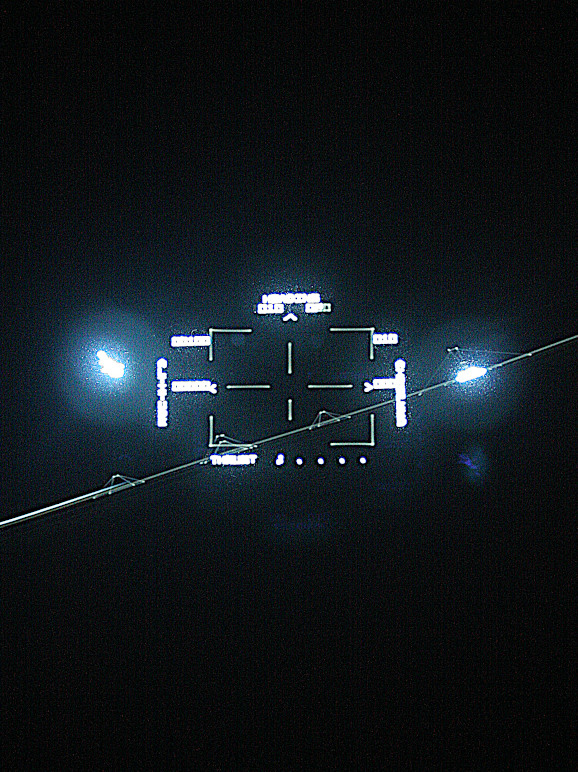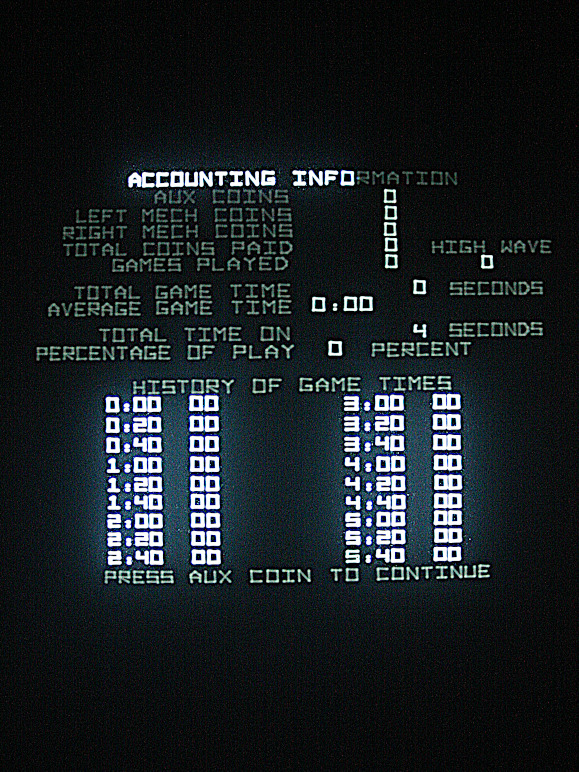VecFever documentation
Tomcat SW
Atari, 1983
Uniquely, a Tomcat prototype romset, an Atari-internal and never fully developed vector game, for the Star Wars pcb survived. Which is interesting for historical reasons but also as an original example to show the working process of how an arcade game might have started. Well, actually anything of a programmer frequently starts: you’ve got something working for a base platform, remove everything unnecessary to have a stable base and then plug in your new code to try things out.
So this is not a prototype of a game, not even close, but an example of the much earlier ‘try an idea out and see where it leads you’ stage. Even more interestingly: Atari engineers built an updated vector pcb using faster processors and this initial 6809 romset for the Star Wars pcb was only the first step. Even a proto. romset for this updated vector hw exists. And this hw never made it into production and probably does not exist anymore at all.
So porting this to be able to run it on the Vectrex was not only idle curiosity. Of course it is just nice to start it up when rereading the arcade bloggers write-up of Tomcat (incidentally not mentioning this earlier romset). But also when I realized that it is a unique, specific window into an early development process was nice motivation-wise. So disassembling and porting this was pleasant for this reason: to see what got ripped out and what remained from my programmers viewpoint. Plus that this is so visible in this romset for everyone since parts of the Star Wars attract are still present. And the cabinet service code is there plus quite a few innards like the reset and irq functionality, but these are of course not directly visible.
Thanks to Ian Buxton who mentioned this earlier, 8-bit romset to me again, it slipped by my radar somehow when I was working on the Star Wars tools.
Inputs
2: switches the cabinet service mode switch (note however that the rom only checks the service switch during attract) and on 4: is mapped either the service forward button, coin-up to start a game or the fire button, depending on the tomcat state.
Only the helicopter is somewhat moveable – and it needs to be selected by 4: or the jet default is used.
Localization
//NAME="TOMCATSW"
//
GERMAN[] = {
{ 0, 0, " Tomcat SW © 1985 Atari. Dies ist ein extrem seltenes, ultrafrühes Romset des Tomcatprototyps für die Atari 6809 Star Wars Hardware. Ein einzigartiges Stück Atari Vektorgeschischte aus mehreren Gründen: Tomcat wurde nie beendet, kam nicht mal nahe. Und doch überlebten nicht nur ein sondern gar zwei Romsets: eins für eine neue Protovektorpcb mit schnelleren CPUs und diese erste, welche auf unmodifizierten Atari Star Wars Platinen läuft. Und diese frühe Variante ist auch interessant aus Entwicklersicht, da es sehr schön zeigt, wie neue Spiele oder Softwareideen erstmal angegangen werden: von etwas funktionierendem wurde alles unwichtige herausgenommen, um erstmal eine stabile Umgebung zu haben. Also bank-switching, Sterne, Audio, das komplette, eigentliche Spiel sind entfernt und anstelle dessen Testcode reingesetzt. Aber der Systemcode - Reset, IRQ, I/O routinen, Teile des Attracts und die Servicefunktionalität des Cabinets blieb drin. Als Resultat ist reichlich Platz im CPU und Vektorrom für Tests und/oder Entwicklung. Dieses Proto.romset ist nicht spielbar: man kann den Helikopter bewegen allerdings ohne Schub. Der Jet ist komplett unbewegbar. Die zusätzliche Schubmessung ist zwar eingebaut hier und verifiziert, dass es in den Tomcat Variablen richtig endet. Aber es ist offensichtlich noch nicht weiter implementiert von TomcatSW. Da TomcatSW nur ein historisches Memento ist habe ich ebenso den Service Switch verfügbar gemacht via 2: (nur während Attract), da es einen weiteren Teil des übernommenen Star Wars Systems zeigt. Für weitere Info. über Tomcat kann ich den sehr netten Tomcat Blog des Arcade Bloggers empfehlen. "}
};
FRENCH[] = {
{ 0, 0, " Tomcat SW © 1985 Atari. Ce prototype de Tomcat est extrêmement ancien et fonctionne sur le matériel Atari 6809 utilisé pour Star Wars. On peut d’ailleurs le considérer comme un morceau unique de l'histoire des jeux vidéo vectoriels d’Atari pour plusieurs raisons : tout d’abord, le jeu Tomcat n'a jamais été terminé et n'a même pas été près de l'être. Malgré cela, il n’y a non pas un, mais deux ensembles distincts de roms qui ont survécu: le second était destiné à un nouveau type de circuits imprimés vectoriels 'Atari' incluant des processeurs plus rapides alors que ce tout premier ensemble fonctionnait sur les circuits imprimés non modifiés de Star Wars. Et ce prototype ci est intéressant pour les développeurs car il montre de façon explicite la genèse d’une nouvelle idée de jeu ou de logiciel: en ce qui concerne l’aspect purement logiciel, tout a été extrait du code de Star Wars afin d’obtenir un environnement de travail suffisamment stable pour procéder à des essais. De fait, on a supprimé la commutation de banque, les étoiles, la partie audio et pour ainsi dire le jeu dans son entier pour pouvoir insérer à la place le code de test. En revanche le code du système - la réinitialisation,l’interruption matérielle, les routines d’E/S, certaines parties de l'attraction et le code de service de la borne ont été conservés. En conséquence, il y a beaucoup d'espace libre dans les roms vectorielles de même qu’au niveau du processeur central pour les tests et/ou la partie développement. Ce prototype n'est pas jouable: on peut déplacer l'hélicoptère mais la poussée des gaz n’est pas opérationnelle; le jet n'est pas du tout mobile. La poussée additionnelle est cependant présente, et j'ai d’ailleurs vérifié qu'elle était correctement intégrée aux variables de Tomcat, mais elle n'est pas encore fonctionnelle ici. Étant donné que ce TomcatSW n'est qu'une curiosité historique, j'ai -une fois n’est pas coutume- également mis à disposition le commutateur de service du circuit imprimé via le bouton 2 (il est uniquement disponible pendant l’attraction) car il montre une autre partie de l'environnement du système de Star Wars tel qu’il est réutilisé. A noter que 'The Arcade Blogger' a écrit sur son blog un excellent article à propos de Tomcat - Je vous invite d’ailleurs à le lire si vous êtes un tant soit peu intéressé. "}
};
ENGLISH[] = {
{ 0, 0, " Tomcat SW © 1985 Atari. This is an extremely early Tomcat prototype running on the Atari 6809 Star Wars Hardware. A unique piece of Atari vector history for multiple reasons: the Tomcat game was never finished and came not even close to being finished. Yet not only one but two separate romsets survived: one for a new Atari vector pcb which inluded faster cpus and this initial one which runs on unmodified Star Wars pcbs. And this early one is interesting from a developers point of view since it shows quite nicely how a new game or software idea was tried: software-wise everything was ripped out of the Star Wars code to get a stable, working environment in which to try things out. So bank-switching, stars, audio, all the actual game was removed and instead the test code put in. But the system code - reset, irq, measurements, parts of the attract and the service code was kept. As a result there is plenty of space in the vector and cpu roms free for tests. This proto. is not playable, you can move the copter around but the thrust is not used, the jet is not moveable at all. I did hook up the additional thrust adc measurement and verified that it correctly gets stored in the tomcat variables but it is apparently not used yet. Since this TomcatSW is just a historic curiousity I for once have also exposed the service switch of the pcb via 2: (only available during attract) since it shows another part of the Star Wars system environment reused. The Arcade Blogger has written up an excellent blog on Tomcat - do read it if you are even remotely interested. "}
};


